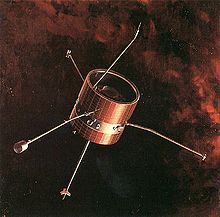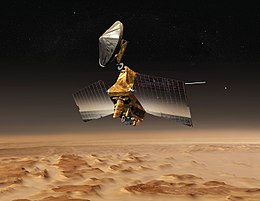Orbiter (space travel)

An orbiter is a space probe that orbits a celestial body . The name is derived from orbit ( orbit ).
Successful missions (selection)
- Sun (7)
- Pioneer 6, 7, 8 and 9 (USA)
- Helios 1 and 2 (USA / Germany)
- Ulysses (USA / Europe)
- Moon (23)
- Luna 10, 11, 12, 19 and 22 (USSR)
- Lunar Orbiter 1, 2, 3, 4 and 5 (USA)
- Explorer 35 and 49 (USA)
- Hiten (Japan)
- Clementine (USA)
- Lunar Prospector (USA)
- SMART-1 (Europe)
- Kaguya (Japan)
- Chang'e-1 and Chang'e-2 (PR China)
- Chandrayaan-1 (India)
- Longjiang 2 (PR China)
- Lunar Reconnaissance Orbiter (USA) - active
- Chandrayaan-2 (India) - active
- Mercury (1)
- MESSENGER (USA)
- Venus (8)
- Venera 9, 10, 15 and 16 (USSR)
- Pioneer Venus 1 (USA)
- Magellan (USA)
- Venus Express (Europe)
- Akatsuki (Japan) - active
- Eros (1)
- NEAR Shoemaker (USA)
- Mars (12)
- Mariner 9 (USA)
- Mars 2, 3 and 5 (USSR)
- Fobos 2 (USSR)
- Mars Global Surveyor (USA)
- 2001 Mars Odyssey (USA) - active
- Mars Express (Europe) - active
- Mars Reconnaissance Orbiter (USA) - active
- Mangalyaan (India) - active
- MAVEN (USA) - active
- ExoMars Trace Gas Orbiter (Europe / Russia) - active
- Vesta (1)
- Dawn (USA)
- Ceres (1)
- Dawn (USA) - active
- Comet 67P / Churyumov-Gerasimenko (1)
- Rosetta (Europe)
- Jupiter (2)
- Saturn (1)
- Cassini (USA)
In addition, as part of the US Apollo program, eight manned Apollo spaceships were swung into lunar orbit: Apollo 8 , 10 , 11 , 12 , 14 , 15 , 16 and 17 .
Started missions (selection)
The following orbiters, among others, have started and are on their way:
- Sun
- Parker Solar Probe (USA), launched August 2018
- Solar Orbiter (Europe), launched in February 2020
- Mercury
- BepiColombo (Europe / Japan) - Orbit around Mercury: December 2025 (planned)
- Mars
- Al-Amal (United Arab Emirates) - launched July 19, 2020
-
Bennu (asteroid)
- OSIRIS-REx (USA) - in orbit around Bennu since December 31, 2018
Planned missions (selection)
Numerous other orbiter launches are planned for the next few years, including:
- Venus
- Shukrayaan-1 (India) - Start: 2023
- Mars
- Martian Moons Exploration (Japan) - Start: 2024
- Asteroids
- Psyche at (16) Psyche - Start: 2022
- Hera (ESA) at (65803) Didymos - Start: 2023
- Jupiter
- JUICE (Europe) - Start: 2022
- Europa Clipper (USA) - Launch: 2023-2025
All start dates are the earliest possible time; Postponements to later years are possible for all missions.
In the long term, orbiters for Jupiter's moon Europa and, as part of a TANDEM mission, for Saturn's moons Titan and Enceladus are being considered.
The Jupiter Icy Moons Orbiter (USA) and the Mars Telecommunications Orbiter (USA) have been canceled for cost reasons . The Mars Science and Telecommunications Orbiter (USA) project has been stopped. The Japanese LUNAR-A was out of date after numerous launch delays. The German LEO project has been postponed .
Other concepts
Two other basic types of spacecraft are the landers and the flyby probes .
The concept of the flyby, which follows the fly-by of a celestial body, is technically and energetically more favorable, since, for example, no brake engines are necessary to swing into an orbit (apart from solar orbit). But this also means that the scientific yield is lower.
When it comes to landers , a distinction is made between hard and soft landings on the solid surface of a celestial body. Hard landing probes will be destroyed by landing. The soft landing is technically far more difficult, especially if a return of the space probe with soil samples is planned. The soft landing probes can be further subdivided into stationary probes, which remain in their place of landing, and mobile probes, which can move on the surface. The latter are commonly referred to as rovers .
